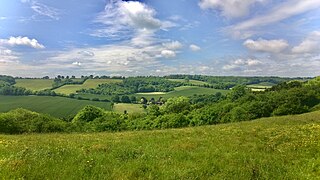
Buckinghamshire, is a ceremonial county in South East England and one of the home counties. It is bordered by Northamptonshire to the north, Bedfordshire to the north-east, Hertfordshire to the east, Greater London to the south-east, Berkshire to the south, and Oxfordshire to the west. The largest settlement is the city of Milton Keynes, and the county town is Aylesbury.
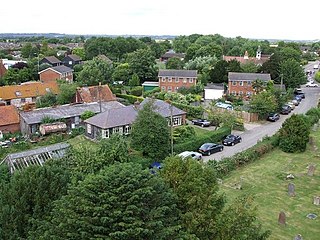
Aston Clinton is a historic village and civil parish in the Vale of Aylesbury in Buckinghamshire, England. The village lies at the foot of the Chiltern Hills, between the Wendover and Aylesbury arms of the Grand Union Canal. Surrounding towns include Wendover to the south, Aylesbury to the west, and Tring to the east - across the nearby county border with Hertfordshire.

In the 19th century members of the English Rothschild family bought and built many country houses in the home counties, furnishing them with the art the family collected. The area of the Vale of Aylesbury, where many of the houses were situated, became known as Rothchildshire. In the 20th century many of these properties were sold off with their art collections dispersed. Today only Eythrope House still belong to the family however they still rentain influence in how Ascott House and Waddesdon Manor are managed. However in the loss of country houses in the 20th century only Aston Clinton was lost.

Addington is a village and civil parish in Buckinghamshire, England, about 2 miles (3.2 km) west of Winslow and 3 miles (4.8 km) south east of Buckingham. According to the 2001 and 2011 census' it had a population of 145. It is part of the Buckinghamshire Council unitary authority area.

Ascott is a hamlet and country house in the parish of Wing, Buckinghamshire, England. The hamlet lies completely within the boundary of the Ascott Estate; it is home to many of the estate and house staff.

Aston Abbotts or Aston Abbots is a village and civil parish in Buckinghamshire, England. It is about 4 miles (6.4 km) north of Aylesbury and 2.5 miles (4 km) south-west of Wing. The parish includes the hamlet of Burston and had a population of 426 at the 2021 Census.

Crafton is a hamlet in the civil parish of Mentmore, in Buckinghamshire, England.

Eythrope is a hamlet and country house in the parish of Waddesdon, in Buckinghamshire, England. It is located to the south east of the main village of Waddesdon. It was bought in the 1870s by a branch of the Rothschild family, and belongs to them to this day.

Ivinghoe is a village and civil parish in east Buckinghamshire, England, close to the borders with Hertfordshire and Bedfordshire. It is 33 miles northwest of London, 4 mi (6 km) north of Tring and 6 mi (10 km) south of Leighton Buzzard, close to the village of Pitstone.

Wing, known in antiquated times as Wyng, is a village and civil parish in east Buckinghamshire, England. The village is on the main A418 road between Aylesbury and Leighton Buzzard. It is about 8 miles (13 km) north-east of Aylesbury, 3 miles (5 km) west of Leighton Buzzard, and 12 miles (19 km) south of Milton Keynes.

Ascott House, sometimes referred to as simply Ascott, is a Grade II* listed building in the hamlet of Ascott near Wing in Buckinghamshire, England. It is set in a 32-acre / 13 hectare estate.

Ledburn is a hamlet in the parish of Mentmore, in Buckinghamshire, England.

Mentmore is a village and civil parish in the Aylesbury Vale district of Buckinghamshire, England. It is about three miles east of Wingrave, three miles south east of Wing.

Mentmore Towers, historically known simply as "Mentmore", is a 19th-century English country house built between 1852 and 1854 for the Rothschild family in the village of Mentmore in Buckinghamshire. Sir Joseph Paxton and his son-in-law, George Henry Stokes, designed the building in the 19th-century revival of late 16th and early 17th-century Elizabethan and Jacobean styles called Jacobethan. The house was designed for the banker and collector of fine art Baron Mayer de Rothschild as a country home, and as a display case for his collection of fine art. The mansion has been described as one of the greatest houses of the Victorian era. Mentmore was inherited by Hannah Primrose, Countess of Rosebery, née Rothschild, and owned by her descendants, the Earls of Rosebery.
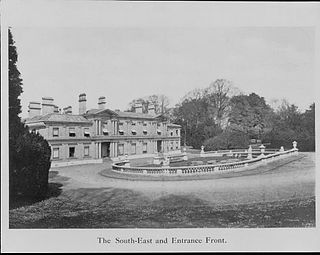
Aston Clinton House was a large mansion to the south-east of the village of Aston Clinton in Buckinghamshire, England.
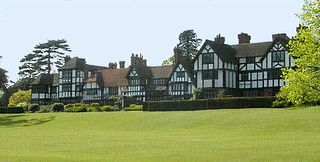
George Devey was an English architect notable for his work on country houses and their estates, especially those belonging to the Rothschild family. The second son of Frederick and Ann Devey, he was born and educated in London.
Wing Rural District was a rural district in the administrative county of Buckinghamshire, England. It was created in 1894 with the name Linslade Rural District, but was renamed Wing Rural District in 1897 when Linslade itself was removed from the district to become an urban district. Wing Rural District was abolished in 1974 to become part of Aylesbury Vale District.
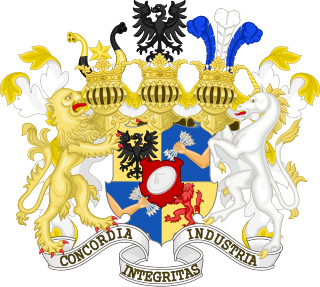
The Rothschild banking family of England was founded in (1798) by Nathan Mayer von Rothschild (1777–1836) who first settled in Manchester but then moved to London, England. Nathan was sent there from his home in Frankfurt by his father, Mayer Amschel Rothschild (1744–1812). Wanting his sons to succeed on their own and to expand the family business across Europe, Mayer Amschel Rothschild had his eldest son remain in Frankfurt, while his four other sons were sent to different European cities to establish a financial institution to invest in business and provide banking services. Nathan Mayer von Rothschild, the third son, first established a textile jobbing business in Manchester and from there went on to establish N M Rothschild & Sons bank in London.
Anthony Gustav de Rothschild was a British banker and member of the Rothschild family.

The Abbey, Aston Abbotts is a country house in Buckinghamshire, England. The house derived its name from being a property of St. Albans Abbey in the Middle Ages, and it belonged to the Dormer family from the Dissolution of the Monasteries until the early 19th century. While in their ownership the house was almost continuously tenanted, and it was altered in a piecemeal way as a result. In the early 20th century it was a secondary seat of the Spencer family of Coles Hall. It was the family home for Captain Harold and Mrs Beatrice Morton in 1923 and sold in 1989 after their deaths. It is now an L-shaped house with a plain, mildly neo-Classical, south front of c.1800, masking a medieval hall and dining-room, and Queen Anne drawing-room at W. end; the smaller west wing is Elizabethan.




















